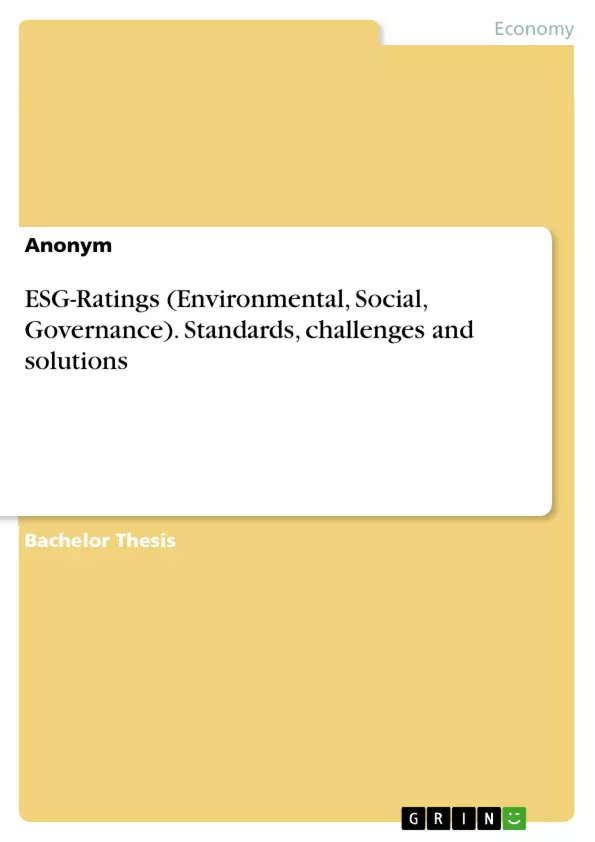This bachelor thesis examines the challenges of ESG ratings and attempts to find a solution to these explored challenges. To answer this question, a theoretical definition of ESG and SRI is given first, followed by a discussion of ratings' theoretical background, standards, and rating agencies' traditional procedures. The classic challenges of ratings are also considered. The differences to ESG ratings are then discussed, and sustainability ratings and sustainability rating agencies are examined. In the following part, the individual challenges of ESG ratings discussed theoretically are described.
After the theoretical foundations, the challenges are clarified in an analysis. The analysis refers to two different industries. Based on the results, possible solutions are proposed and discussed. A conclusion is followed. Sustainability has been a highly debated topic for a long time. Waste separation, the purchase of regional food, electricity supply options and the fight against plastic waste are indispensable topics for society. The matter has not yet played such a significant role in financial investments, but interest is growing. Millennials are open to sustainable investments.
This area of interest is shown by a representative YouGov study commissioned by the fund company Deka. Nevertheless, only six per cent of investors own sustainable investments. This occurrence is maybe because the topic is complex for investors to grasp. There is even a lack of a generally valid definition of sustainability. There are indeed several quality seals that make orientation easier, but there are no standards. The EU Commission wants to change that and is working on critical criteria for sustainable investments, but it will be some time before these are fully implemented throughout the EU.
Inhaltsverzeichnis (Table of Contents)
- Introduction
- Term discussion SRI and ESG
- SRI - Socially Responsibility Investment
- ESG - Environment, Social and Governance Investing
- Ratings - Standards
- Types of ratings
- Rating Agencies
- Challenges of ratings
- Structured products
- Compensation of rating agencies
- Ratings in ESG
- Difference between credit ratings and ESG ratings
- Approaches of rating agencies
- Regulation of ESG
- Challenges of ESG ratings
- Different approaches
- Transparency
- Bias and reliability
- Lack of independence
- Greenwashing
- Outline of the challenges
- Course of action
- Chosen industries
- Controversy in the fashion industry
- Controversy in the automobile industry
- Evaluation and debate on solutions
- Stricter regulations
- Building a metrics
- Determine own standards
- Recommendation for action and conclusion
Zielsetzung und Themenschwerpunkte (Objectives and Key Themes)
This Bachelor thesis aims to analyze the challenges associated with Environmental, Social, and Governance (ESG) ratings. It examines the different types of ratings, the role of rating agencies, and the controversies surrounding the methodology and reliability of these assessments.
- ESG Ratings and their significance in investment decisions
- The role of rating agencies and their methodologies
- Challenges and controversies related to ESG ratings, including transparency, bias, and greenwashing
- Potential solutions and recommendations for improving the effectiveness of ESG ratings
- Examples of ESG controversies in specific industries, such as fashion and automobiles
Zusammenfassung der Kapitel (Chapter Summaries)
The thesis begins by introducing the concepts of Socially Responsible Investment (SRI) and ESG investing. It explores the evolution of these concepts and their implications for investors.
Chapter 3 delves into the complexities of ESG ratings, discussing different types of ratings, the role of rating agencies, and the challenges associated with their use. It highlights the importance of standardization and the need for robust methodologies to ensure reliable assessments.
Chapter 4 specifically examines the application of ESG ratings in the context of investment decisions. It analyzes the differences between credit ratings and ESG ratings, explores various approaches employed by rating agencies, and examines the ongoing regulatory landscape for ESG. The chapter also sheds light on key challenges, including the potential for greenwashing and the need for greater transparency and independence in the rating process.
The thesis concludes by outlining a course of action for addressing these challenges. It proposes specific recommendations, such as stricter regulations, the development of standardized metrics, and the establishment of industry-specific standards for ESG assessments.
Schlüsselwörter (Keywords)
ESG ratings, Socially Responsible Investment (SRI), Environment, Social, and Governance (ESG), Rating agencies, greenwashing, transparency, bias, reliability, regulation, investment decisions, industry controversies, fashion industry, automobile industry.
- Quote paper
- Anonym (Author), 2021, ESG-Ratings (Environmental, Social, Governance). Standards, challenges and solutions, Munich, GRIN Verlag, https://www.grin.com/document/1138672



